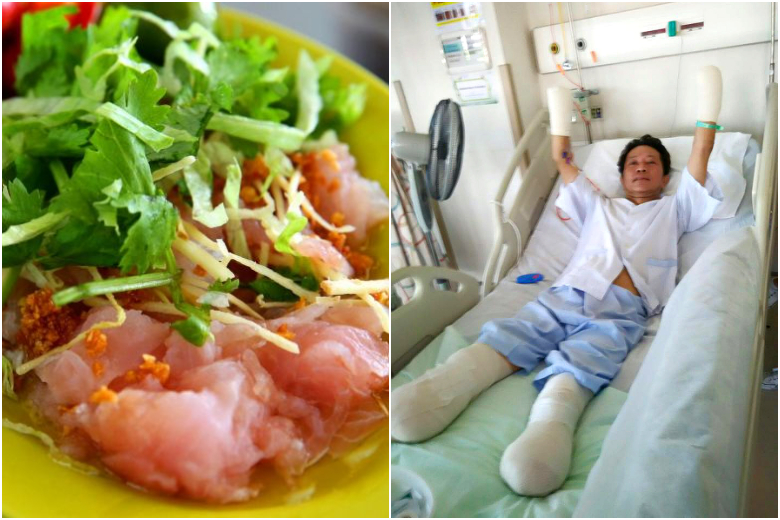Spike in GBS cases: 7 things to know about the infection previously linked to raw fish
Sign up now: Get ST's newsletters delivered to your inbox

Group B Streptococcus survivor Tan Whee Boon lost all four limbs to the infection in 2015, following a raw fish meal.
PHOTOS: ST FILE, CHOONG SIET MEI
Linette Lai and Jessie Lim , Linette Lai, Jessie Lim
Follow topic:
This article was first published on Nov 27, 2015, and updated on Aug 31, 2020
SINGAPORE - There were 50 cases of invasive Group B Streptococcus (GBS) reported by public hospitals in July - twice the average monthly figure of 25 from January to June this year.
Eighteen of these cases were infected by a particularly potent strain of GBS, known as Sequence Type 283 (ST283). The profile of these patients is similar to that of those who were infected by the same bacterium in a 2015 outbreak caused by eating raw freshwater fish.
1. WHAT IS GROUP B STREPTOCOCCUS BACTERIA (GBS)?
It is a bacterium commonly found in the gut and urinary tract of about 15 to 30 per cent of adults without causing any disease. But it may occasionally cause infections of the skin, joints, heart and brain. It can lead to meningitis, which is an inflammation of the membranes surrounding the brain and spinal cord.
Having chronic conditions such as diabetes puts people at a higher risk of getting infected.
2. WHY IS GBS IN THE NEWS NOW?
There were 50 GBS cases reported by public hospitals in July - twice the average monthly figure of 25 from Jan to June this year.
Of these 50 GBS cases, 18 were infected by a particularly potent strain of GBS, ST283, up from an average of four cases a month from April to June.
While most patients have recovered, one has died from unrelated causes.
3. WHAT HAPPENED IN THE 2015 GBS OUTBREAK?
The GBS outbreak that killed two people here was the largest of its kind in the world. While GBS is described as normally harmless, there were 360 cases in the 2015 outbreak.
Of those infected, 160 had been infected by ST283 and suffered fever, joint infection and meningitis.
The 2015 outbreak was also the first time that food-borne transmission to people was proven, said Dr Hsu Li Yang who was then at the National University Hospital.
Although the GBS outbreak occurred here, researchers from Tan Tock Seng Hospital and the Agency for Science, Technology and Research confirmed that the ST283 strain was a regional threat "not unique to Singapore".
They announced in July last year that this GBS variant had caused disease in people and freshwater fish in South-east Asia for over two decades.
4. WHAT IS DIFFERENT THIS YEAR?
GBS ST283 had not been detected in fish samples as at last Sunday, said the Ministry of Health (MOH) and the Singapore Food Agency (SFA).
The samples taken were part of routine SFA testing between May last year and August this year.
None of the food stalls visited by patients who recently contracted GBS had sold raw fish dishes, the authorities added.
About 150 of the 360 cases reported in 2015 were linked to the consumption of raw freshwater fish common in Chinese cooking. These included toman, also known as snakehead fish; song, also known as Asian bighead carp; and tilapia.
The National Environment Agency then banned the use of all freshwater fish in ready-to-eat raw fish dishes in December 2015.
Health Ministry medical services director Kenneth Mak noted in a circular distributed within the medical community last Friday (Aug 28) that most of the 18 people infected by GBS ST283 in July were aged 65 years and above, who developed septicaemia or bacteraemia, commonly known as blood poisoning.
Two of most serious cases of GBS infection reported in 2015 were under 65. One was a 50-year-old man who lost all his limbs to the disease, while the other was 52-year-old man who fell into a coma for two weeks and lost his hearing.
5. ARE SOME PEOPLE MORE PRONE TO INFECTION?
In general, newborns and people with poorer immunity, such as those with diabetes, cancer and HIV, are usually more vulnerable to the infection, say doctors. But the cases in 2015 affected both young adults and the old.
Traditionally, GBS infections have been associated with pregnancy as mothers who are carriers of the bacterium may pass them to their babies during birth.
6. WHAT ARE THE SYMPTOMS AND HOW CAN THEY BE TREATED?
The most common symptom is a fever, said Dr Leong Hoe Nam, an infectious diseases specialist at Mount Elizabeth Novena Hospital.
It is important to recognise and address it early, added Dr Leong, noting that it can be treated with common antibiotics such as penicillin.
Other more serious symptoms include infection of the joints, brain, lungs and other soft tissue. The kind of symptoms a person has depends on the site of the bacterial infection.
7. HOW CAN I PROTECT MYSELF?
Precautionary measures include washing your hands and kitchen utensils well before handling food, which should then be cooked thoroughly.
Using separate sets of knives and cutting boards for preparing raw and cooked food is also recommended.

